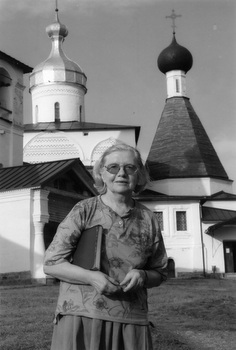 Olga Vladimirovna Lelekova, outstanding restorer and researcher of Old Russian art, died on the night of the 6th / 7th March, she was 82 years old. In 1961, she came to the Institute of Restoration where she headed the Department of Tempera Painting Restoration during 43 years, from 1966 to 2009. She was a wonderful organizer who managed to gather the best restorers in her department. They had the most ambitious goals and prestige not only in Russia, but also abroad. Olga Lelekova worked as a restorer and researcher in Novgorod, the Kirillo-Belozersky Museum-Reserve, Belozersk, Veliky Ustyug, Tallinn, Vilnius, Minsk, Lvov, the Trinity Sergius Lavra, in the Philippines, Finland, Germany, France and Lebanon. The Russian school of scientific restoration was constantly connected with O.V. Lelekova and the State Research and Development Institute of Restoration.
Olga Vladimirovna Lelekova, outstanding restorer and researcher of Old Russian art, died on the night of the 6th / 7th March, she was 82 years old. In 1961, she came to the Institute of Restoration where she headed the Department of Tempera Painting Restoration during 43 years, from 1966 to 2009. She was a wonderful organizer who managed to gather the best restorers in her department. They had the most ambitious goals and prestige not only in Russia, but also abroad. Olga Lelekova worked as a restorer and researcher in Novgorod, the Kirillo-Belozersky Museum-Reserve, Belozersk, Veliky Ustyug, Tallinn, Vilnius, Minsk, Lvov, the Trinity Sergius Lavra, in the Philippines, Finland, Germany, France and Lebanon. The Russian school of scientific restoration was constantly connected with O.V. Lelekova and the State Research and Development Institute of Restoration.
Olga Lelekova considerably expanded the horizons of restoration of tempera painting and applied the technology of the icon restoration to the Russian monumental painting. Since 1982, she was at the head of the large-scale restoration of the frescoes of 1502 in the Nativity of the Virgin Cathedral of the Ferapontov Monastery. She involved chemical technologists, microbiologists and climatologists in this work. This precise restoration lasted for 30 years. Such a method had never been applied to monumental painting before. It ensured preservation of the Dionisy’s frescoes in Ferapontovo in the years ahead. In 1998, Olga Lelekova and seven members of her group were awarded the State Prizes of the Russian Federation.
Olga Lelekova proved herself to be a historian and art critic simultaneously with practical restoration. Her researches resulted in the two-volume book “The Iconostasis of the Assumption Cathedral in the Kirillo-Belozersky Monastery of 1497”. It was published in 2011.
The senior generation of the restorers and researchers in the Institute of Restoration died with the death of O.V. Lelekova. But they will be always remembered thanks to the masterpieces of the Russian fine art that they have saved.







